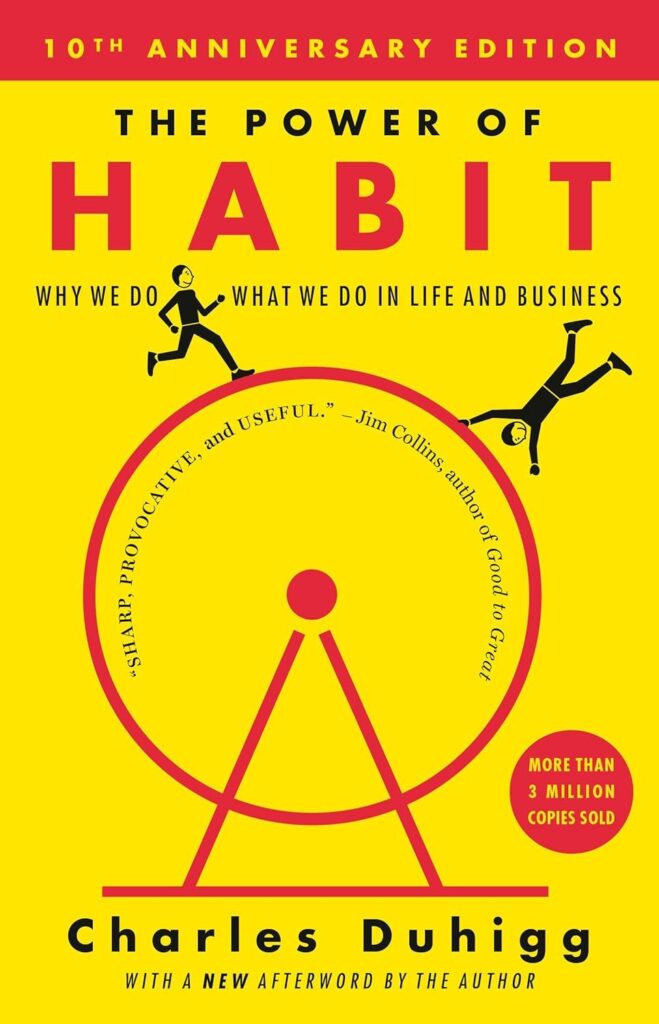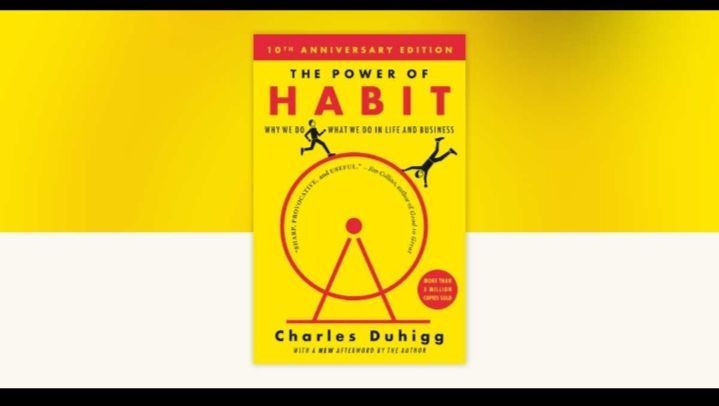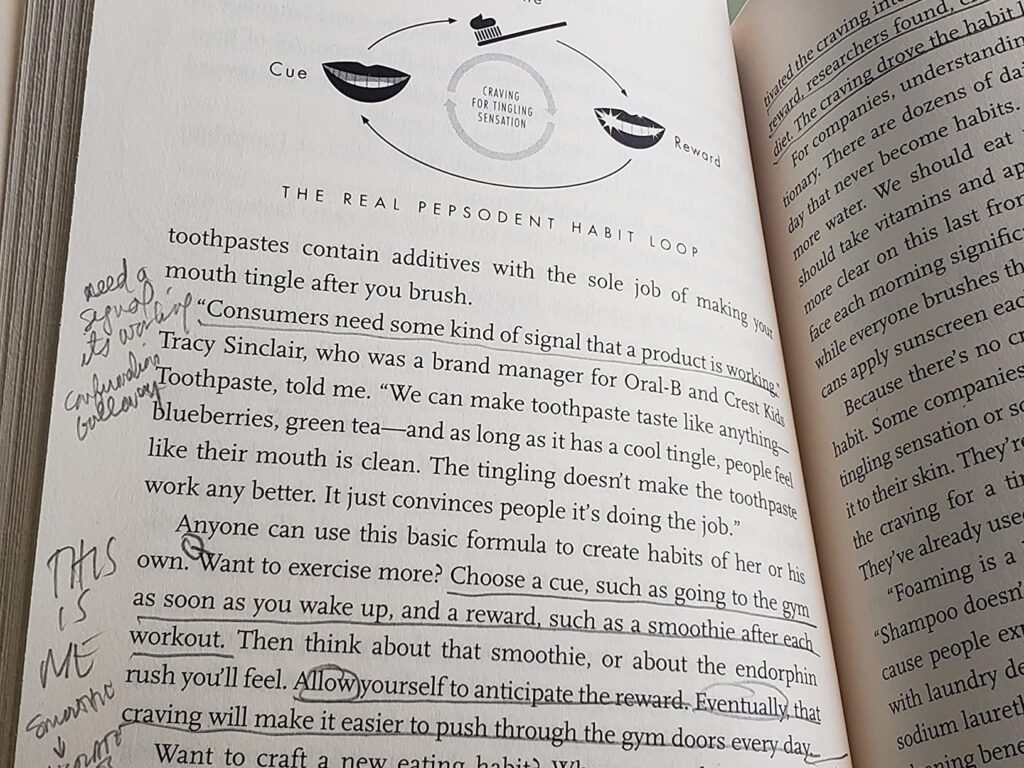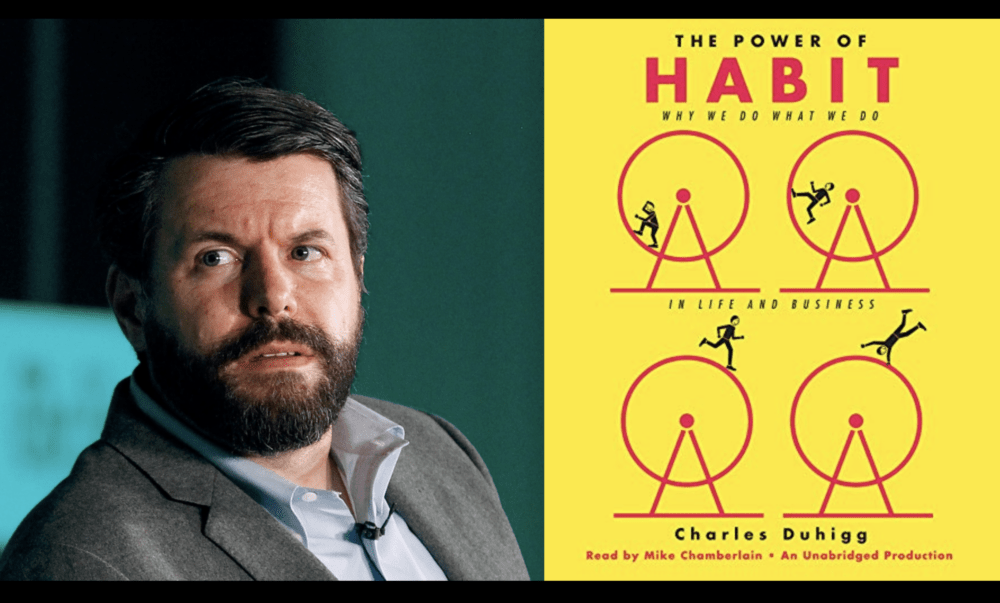
When people search for The Power of Habit Summary, they are usually not just looking for a list of ideas.
What they want deep down is a practical explanation of how habits work and how they can change their own routines. Many of us feel stuck in patterns that don’t serve us hitting snooze too many times, scrolling endlessly on social media, or giving up on the gym after a week.
The solution Charles Duhigg offers is surprisingly simple but incredibly powerful: by understanding the habit loop cue, routine, reward you can break bad patterns and design better ones.
This is the heart of The Power of Habit, and it’s what makes the book so useful for anyone who wants real transformation.
What Is The Power of Habit About?

At its core, The Power of Habit is a book about why we do what we do.
Charles Duhigg explains that habits aren’t signs of weakness or strength; they are simply the brain’s way of saving energy.
When a behavior repeats enough, the brain moves it into an automatic loop, freeing up mental space for other things.
This is why you can drive home without consciously thinking of every turn, or brush your teeth at night without debating whether you should or not.
But while habits make life easier, they can also trap us. Smoking, overeating, procrastinating these are all habits too.
The real message of the book is empowering: habits are not destiny. They can be studied, understood, and reshaped.
Duhigg brings this point to life through stories of Olympic swimmers, corporate executives, and ordinary people who’ve turned their lives around by mastering small changes.
The Habit Loop: Cue, Routine, Reward
One of the most important ideas in The Power of Habit Summary is the habit loop. Every habit, whether positive or destructive, follows the same three-part pattern:

1. Cue – a trigger or signal that starts the behavior.
2. Routine – the behavior itself, often automatic.
3. Reward – the benefit or relief that reinforces the loop.
Think about finishing dinner and suddenly craving something sweet.
The cue is the end of the meal, the routine is eating dessert, and the reward is the satisfaction your brain associates with sugar. Over time, this becomes so automatic that you crave dessert every night, even if you’re not hungry.
The beauty of this model is that it shows us where change is possible. You don’t need to eliminate the cue or deny yourself the reward. Instead, you focus on replacing the routine.
Maybe after dinner, instead of reaching for cake, you brew a cup of herbal tea or take a short walk. The cue is the same, the reward is similar (comfort, relaxation), but the routine changes.
This is how habits are reshaped not by willpower alone, but by redesigning the loop.
Keystone Habits: Small Shifts, Big Impact
One of the most powerful insights in the book is the idea of keystone habits. These are habits that don’t just create change on their own they spark a ripple effect across other parts of life.
Take exercise as an example. Someone who starts jogging three times a week may not only get fitter but also begin eating healthier, sleeping better, and becoming more productive at work.
The initial habit sets off a chain reaction. Duhigg shares the story of how companies and individuals discovered that focusing on a single keystone habit could transform everything.
This idea feels deeply human because we often think we have to fix everything at once. The Power of Habit reassures us that starting small is enough. You don’t need to rebuild your life overnight; you just need to find one meaningful habit that unlocks others naturally.
Habits in Organizations and Society
Habits don’t just shape individuals they influence entire companies and even social movements.
In The Power of Habit, Duhigg explores how businesses thrive when they design systems around powerful routines. For example, Starbucks trains employees not just in customer service but in specific habit-based routines to handle stress and create consistency.
The book also dives into how social change is driven by shared habits. The civil rights movement, for instance, gained strength not only from leaders like Martin Luther King Jr.
but also from the social habits of communities neighbors encouraging one another, congregations gathering weekly, and networks reinforcing action.
This part of the book reminds us that habits are not private quirks; they’re part of the larger fabric of human behavior.
When we understand them, we understand why organizations succeed or fail, and why societies move forward or stay stuck.
Willpower as a Muscle
Another fascinating lesson in The Power of Habit Summary is the idea that willpower functions like a muscle. It can be trained, strengthened, and also exhausted.
People who succeed long-term don’t necessarily have more raw discipline than others; they’ve built systems that protect their willpower

For instance, preparing meals ahead of time reduces the daily strain of deciding what to eat.
Setting a fixed bedtime reduces the need to battle with yourself every night. By automating decisions through habits, you conserve willpower for the moments that truly matter.
This insight feels comforting because many of us blame ourselves for “not having enough discipline.
” Duhigg reframes it: it’s not about being stronger, it’s about being smarter with your energy.
Applying the Lessons in Daily Life
So how do you actually use these lessons? Reading The Power of Habit is inspiring, but the real transformation happens when you apply it. Here are a few steps, written from a human perspective:
Notice your cues: Pay attention to what triggers your behaviors. Is it stress? Boredom? A time of day? Awareness is the first step.
Experiment with routines: Instead of quitting a bad habit cold turkey, try swapping in a healthier action that gives a similar reward.
Choose a keystone habit: Don’t try to change everything at once. Pick one small but powerful habit, like journaling for five minutes or exercising twice a week.
Shape your environment: Make the good habits visible and the bad ones inconvenient. Place your running shoes by the door, hide the snacks at the back of the cupboard.
Be patient with yourself: Habits take time to rewire. Some days you’ll succeed, other days you’ll slip. That’s normal the key is persistence.
Why The Power of Habit Resonates
What makes this book so impactful is the way it blends science with storytelling. Instead of just listing studies, Duhigg introduces us to real people from Olympic athletes to business leaders who’ve lived through the principles. The reader walks away not just with knowledge, but with a sense of possibility.
It resonates because it touches something universal: the feeling that our lives are shaped by forces we don’t always control, and the relief that comes when we realize we can take that control back.
About the Author: Charles Duhigg

Charles Duhigg is a Pulitzer Prize–winning journalist and author best known for his work on habits, productivity, and human behavior. Before writing The Power of Habit, he spent years researching psychology, neuroscience, and real-world case studies to understand why people do what they do. His background as a reporter for The New York Times gave him access to powerful stories from Olympic athletes to corporate leaders that made his writing both scientific and relatable.
What makes Duhigg’s work resonate is not only the depth of research but also his talent for storytelling. He takes complex ideas and turns them into engaging narratives that anyone can understand. Beyond The Power of Habit, he also wrote Smarter Faster Better, which explores the science of productivity. Together, his books continue to help millions of readers rethink how they work, live, and grow.
Want to Dive Deeper?
Reading a summary is a great way to capture the key ideas, but nothing replaces the full experience of the book itself. If The Power of Habit inspired you, you might enjoy exploring the complete version.
Read also : Atomic Habits vs The Power of Habit: The Ultimate Guide to Building Better Habits
Conclusion: Becoming the Architect of Your Habits
This Power of Habit Summary shows that habits are powerful, but not permanent. By understanding the habit loop, focusing on keystone habits, and treating willpower as a muscle, you gain the ability to redesign your life one small choice at a time.
The human truth is simple: none of us are stuck. Our brains are wired for change, and the patterns that hold us back today can become the stepping stones to growth tomorrow. You don’t have to fight your habits endlessly you just have to learn how they work, and then become the architect of the life you truly want.
Frequently Asked Questions about The Power of Habit
1. What is the main message of The Power of Habit?
The main message is that habits are not destiny. By understanding the habit loop cue, routine, and reward you can reshape bad patterns and create positive ones.
2. How does The Power of Habit explain habit formation?
Charles Duhigg explains that habits form when the brain learns to associate a cue with a routine and a reward. Over time, this loop becomes automatic, which is why habits feel so hard to break.
3. What are keystone habits?
Keystone habits are powerful routines that spark changes in other areas of life. For example, regular exercise often leads to healthier eating, better sleep, and improved productivity.
4. Is The Power of Habit practical or just theoretical?
The book blends science with real-life stories. While it explains the psychology and neuroscience behind habits, it also provides practical examples and strategies you can apply immediately.
5. Who should read The Power of Habit?
Anyone interested in personal growth, productivity, or behavior change will benefit. It’s especially useful if you struggle with breaking bad habits or want to build stronger routines.
6. How is The Power of Habit different from Atomic Habits?
While The Power of Habit focuses on the science and stories behind habits, Atomic Habits is more of a step-by-step guide. Many readers find that the two books complement each other.
